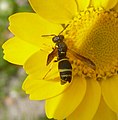File:Odynerus spinipes^ Vespidae. See parasite note - Flickr - gailhampshire.jpg
Appearance

Size of this preview: 519 × 600 pixels. Other resolutions: 208 × 240 pixels | 415 × 480 pixels | 654 × 756 pixels.
Original file (654 × 756 pixels, file size: 166 KB, MIME type: image/jpeg)
File history
Click on a date/time to view the file as it appeared at that time.
| Date/Time | Thumbnail | Dimensions | User | Comment | |
|---|---|---|---|---|---|
| current | 13:21, 14 October 2017 |  | 654 × 756 (166 KB) | Chiswick Chap | Cropped 31 % horizontally and 22 % vertically using CropTool with precise mode. |
| 21:48, 8 July 2016 |  | 952 × 972 (183 KB) | Josve05a | == {{int:filedesc}} == {{Information |Description=Most Strepsiptera (also known as twisted-wing parasites) live as internal parasites of bees, wasps, grasshoppers, leafhoppers, and other members of the order Hemiptera. Only a few species that parasit... |
File usage
The following 3 pages use this file:
Global file usage
The following other wikis use this file:
- Usage on fa.wikipedia.org
- Usage on gl.wikipedia.org
- Usage on ja.wikipedia.org
- Usage on la.wikipedia.org
- Usage on tr.wikipedia.org
